Comprehensive Risk Management Report: Western Sydney Airport Project
VerifiedAdded on 2021/02/20
|22
|6435
|29
Report
AI Summary
This report presents a comprehensive risk management analysis for the Western Sydney Airport project, encompassing various aspects from project initiation to risk response strategies. It begins with an introduction to the project, including a detailed project charter outlining the project's scope, objectives, and components. The report emphasizes the importance and benefits of risk management in the context of this large-scale infrastructure project, highlighting its role in ensuring project success, meeting deadlines, and communicating objectives with stakeholders. The core of the report delves into the risk identification process, outlining the steps involved and the tools and techniques used, such as brainstorming, SWOT analysis, and document reviews. Qualitative risk analysis, including the use of a probability and impact matrix, risk ranking, and the development of a risk register, is also discussed. Furthermore, the report explores quantitative risk analysis, specifically the application of Monte Carlo simulation for the top risks. Finally, it addresses risk response strategies, providing a holistic view of managing potential challenges and ensuring the successful completion of the Western Sydney Airport project.

Western Sydney new
airport
airport
Paraphrase This Document
Need a fresh take? Get an instant paraphrase of this document with our AI Paraphraser
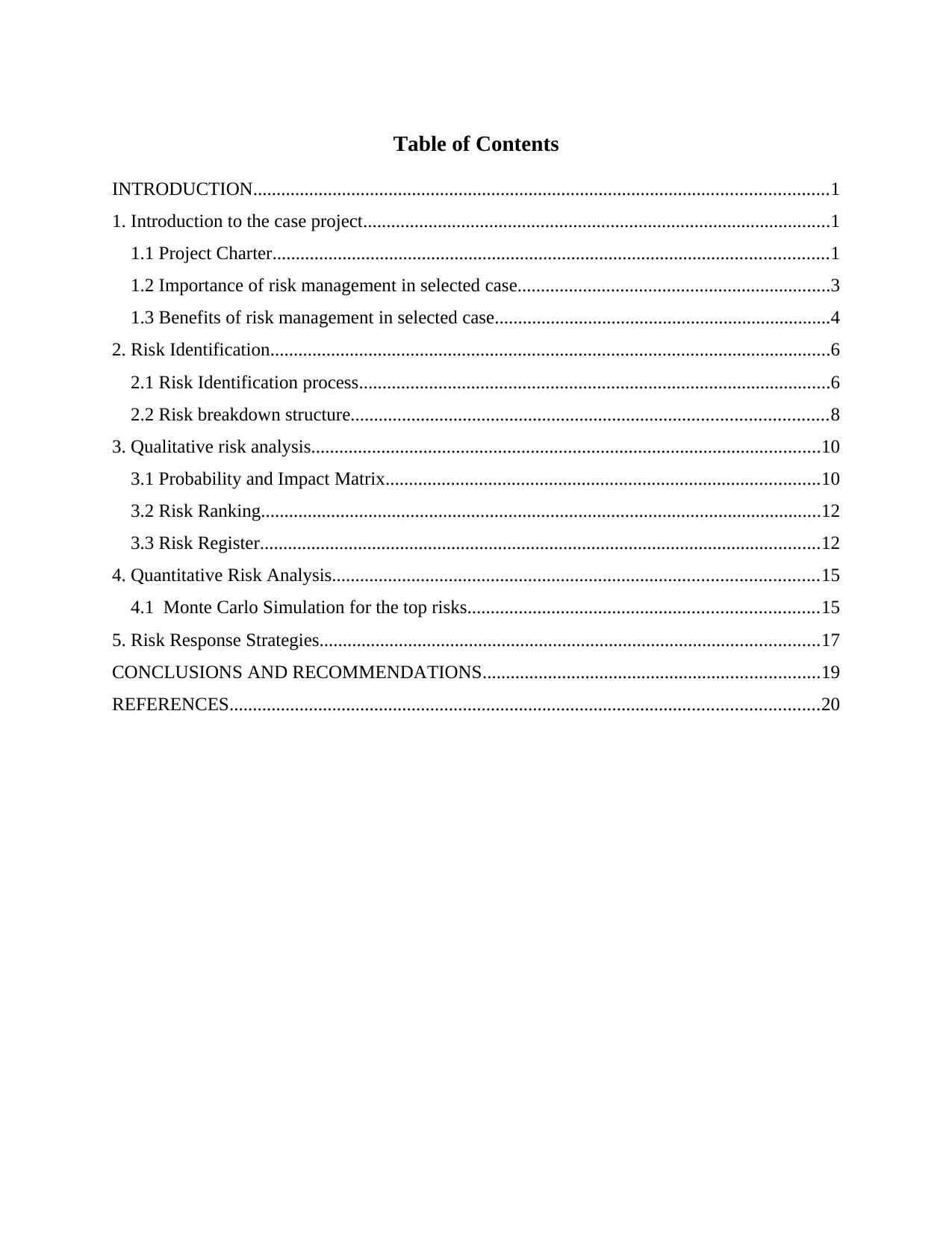
Table of Contents
INTRODUCTION...........................................................................................................................1
1. Introduction to the case project....................................................................................................1
1.1 Project Charter.......................................................................................................................1
1.2 Importance of risk management in selected case...................................................................3
1.3 Benefits of risk management in selected case........................................................................4
2. Risk Identification........................................................................................................................6
2.1 Risk Identification process.....................................................................................................6
2.2 Risk breakdown structure......................................................................................................8
3. Qualitative risk analysis.............................................................................................................10
3.1 Probability and Impact Matrix.............................................................................................10
3.2 Risk Ranking........................................................................................................................12
3.3 Risk Register........................................................................................................................12
4. Quantitative Risk Analysis........................................................................................................15
4.1 Monte Carlo Simulation for the top risks...........................................................................15
5. Risk Response Strategies...........................................................................................................17
CONCLUSIONS AND RECOMMENDATIONS........................................................................19
REFERENCES..............................................................................................................................20
INTRODUCTION...........................................................................................................................1
1. Introduction to the case project....................................................................................................1
1.1 Project Charter.......................................................................................................................1
1.2 Importance of risk management in selected case...................................................................3
1.3 Benefits of risk management in selected case........................................................................4
2. Risk Identification........................................................................................................................6
2.1 Risk Identification process.....................................................................................................6
2.2 Risk breakdown structure......................................................................................................8
3. Qualitative risk analysis.............................................................................................................10
3.1 Probability and Impact Matrix.............................................................................................10
3.2 Risk Ranking........................................................................................................................12
3.3 Risk Register........................................................................................................................12
4. Quantitative Risk Analysis........................................................................................................15
4.1 Monte Carlo Simulation for the top risks...........................................................................15
5. Risk Response Strategies...........................................................................................................17
CONCLUSIONS AND RECOMMENDATIONS........................................................................19
REFERENCES..............................................................................................................................20
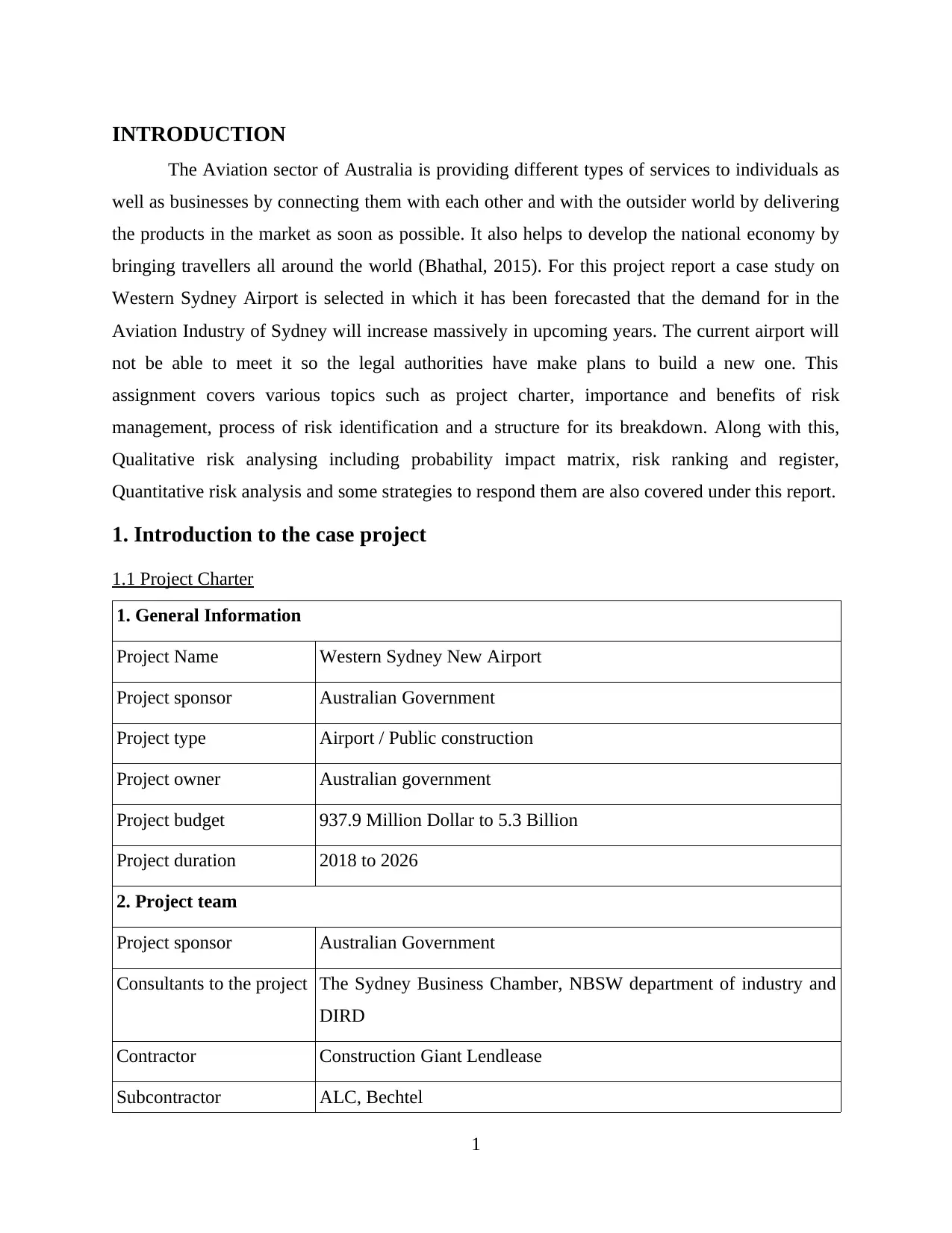
INTRODUCTION
The Aviation sector of Australia is providing different types of services to individuals as
well as businesses by connecting them with each other and with the outsider world by delivering
the products in the market as soon as possible. It also helps to develop the national economy by
bringing travellers all around the world (Bhathal, 2015). For this project report a case study on
Western Sydney Airport is selected in which it has been forecasted that the demand for in the
Aviation Industry of Sydney will increase massively in upcoming years. The current airport will
not be able to meet it so the legal authorities have make plans to build a new one. This
assignment covers various topics such as project charter, importance and benefits of risk
management, process of risk identification and a structure for its breakdown. Along with this,
Qualitative risk analysing including probability impact matrix, risk ranking and register,
Quantitative risk analysis and some strategies to respond them are also covered under this report.
1. Introduction to the case project
1.1 Project Charter
1. General Information
Project Name Western Sydney New Airport
Project sponsor Australian Government
Project type Airport / Public construction
Project owner Australian government
Project budget 937.9 Million Dollar to 5.3 Billion
Project duration 2018 to 2026
2. Project team
Project sponsor Australian Government
Consultants to the project The Sydney Business Chamber, NBSW department of industry and
DIRD
Contractor Construction Giant Lendlease
Subcontractor ALC, Bechtel
1
The Aviation sector of Australia is providing different types of services to individuals as
well as businesses by connecting them with each other and with the outsider world by delivering
the products in the market as soon as possible. It also helps to develop the national economy by
bringing travellers all around the world (Bhathal, 2015). For this project report a case study on
Western Sydney Airport is selected in which it has been forecasted that the demand for in the
Aviation Industry of Sydney will increase massively in upcoming years. The current airport will
not be able to meet it so the legal authorities have make plans to build a new one. This
assignment covers various topics such as project charter, importance and benefits of risk
management, process of risk identification and a structure for its breakdown. Along with this,
Qualitative risk analysing including probability impact matrix, risk ranking and register,
Quantitative risk analysis and some strategies to respond them are also covered under this report.
1. Introduction to the case project
1.1 Project Charter
1. General Information
Project Name Western Sydney New Airport
Project sponsor Australian Government
Project type Airport / Public construction
Project owner Australian government
Project budget 937.9 Million Dollar to 5.3 Billion
Project duration 2018 to 2026
2. Project team
Project sponsor Australian Government
Consultants to the project The Sydney Business Chamber, NBSW department of industry and
DIRD
Contractor Construction Giant Lendlease
Subcontractor ALC, Bechtel
1
⊘ This is a preview!⊘
Do you want full access?
Subscribe today to unlock all pages.

Trusted by 1+ million students worldwide
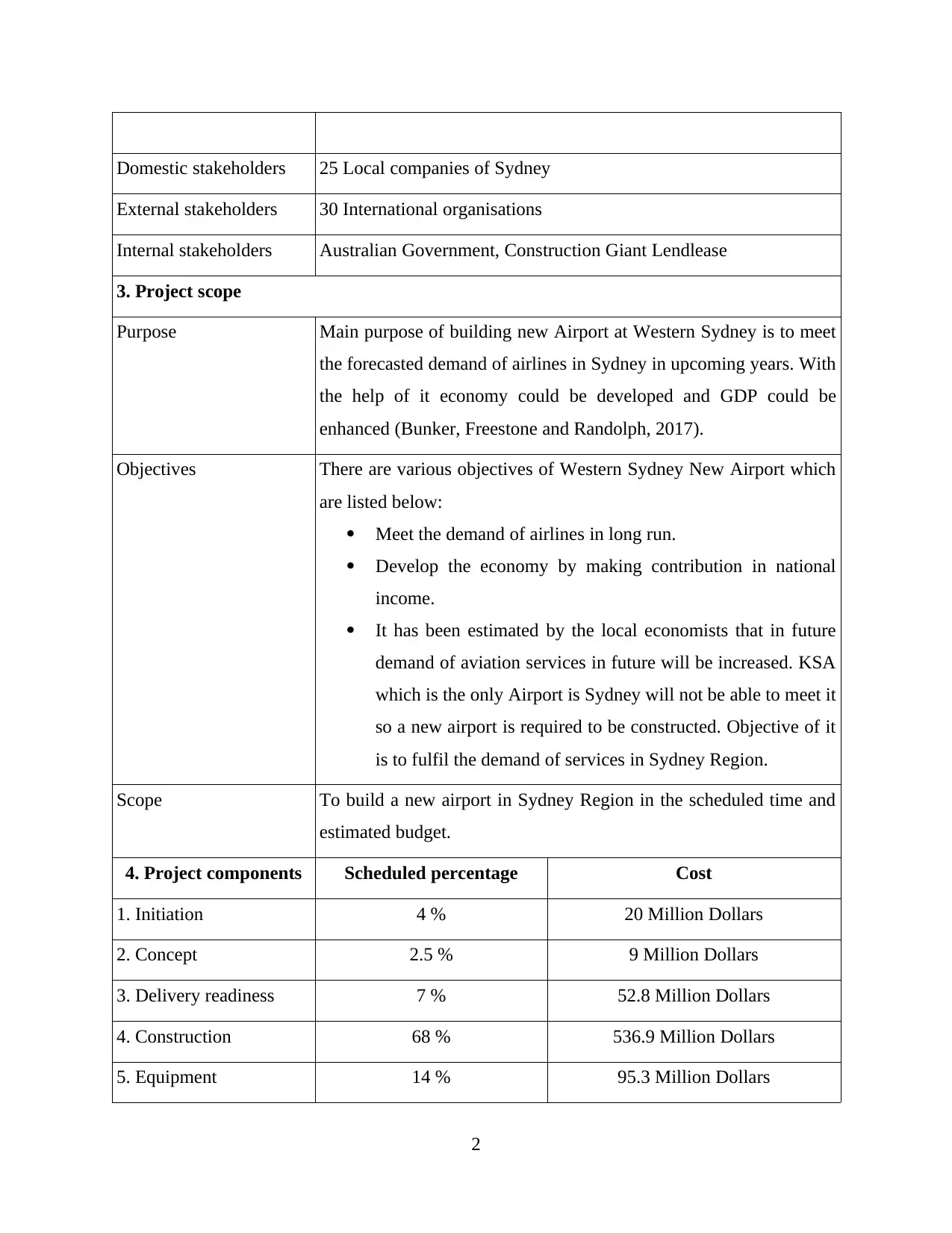
Domestic stakeholders 25 Local companies of Sydney
External stakeholders 30 International organisations
Internal stakeholders Australian Government, Construction Giant Lendlease
3. Project scope
Purpose Main purpose of building new Airport at Western Sydney is to meet
the forecasted demand of airlines in Sydney in upcoming years. With
the help of it economy could be developed and GDP could be
enhanced (Bunker, Freestone and Randolph, 2017).
Objectives There are various objectives of Western Sydney New Airport which
are listed below:
Meet the demand of airlines in long run.
Develop the economy by making contribution in national
income.
It has been estimated by the local economists that in future
demand of aviation services in future will be increased. KSA
which is the only Airport is Sydney will not be able to meet it
so a new airport is required to be constructed. Objective of it
is to fulfil the demand of services in Sydney Region.
Scope To build a new airport in Sydney Region in the scheduled time and
estimated budget.
4. Project components Scheduled percentage Cost
1. Initiation 4 % 20 Million Dollars
2. Concept 2.5 % 9 Million Dollars
3. Delivery readiness 7 % 52.8 Million Dollars
4. Construction 68 % 536.9 Million Dollars
5. Equipment 14 % 95.3 Million Dollars
2
External stakeholders 30 International organisations
Internal stakeholders Australian Government, Construction Giant Lendlease
3. Project scope
Purpose Main purpose of building new Airport at Western Sydney is to meet
the forecasted demand of airlines in Sydney in upcoming years. With
the help of it economy could be developed and GDP could be
enhanced (Bunker, Freestone and Randolph, 2017).
Objectives There are various objectives of Western Sydney New Airport which
are listed below:
Meet the demand of airlines in long run.
Develop the economy by making contribution in national
income.
It has been estimated by the local economists that in future
demand of aviation services in future will be increased. KSA
which is the only Airport is Sydney will not be able to meet it
so a new airport is required to be constructed. Objective of it
is to fulfil the demand of services in Sydney Region.
Scope To build a new airport in Sydney Region in the scheduled time and
estimated budget.
4. Project components Scheduled percentage Cost
1. Initiation 4 % 20 Million Dollars
2. Concept 2.5 % 9 Million Dollars
3. Delivery readiness 7 % 52.8 Million Dollars
4. Construction 68 % 536.9 Million Dollars
5. Equipment 14 % 95.3 Million Dollars
2
Paraphrase This Document
Need a fresh take? Get an instant paraphrase of this document with our AI Paraphraser
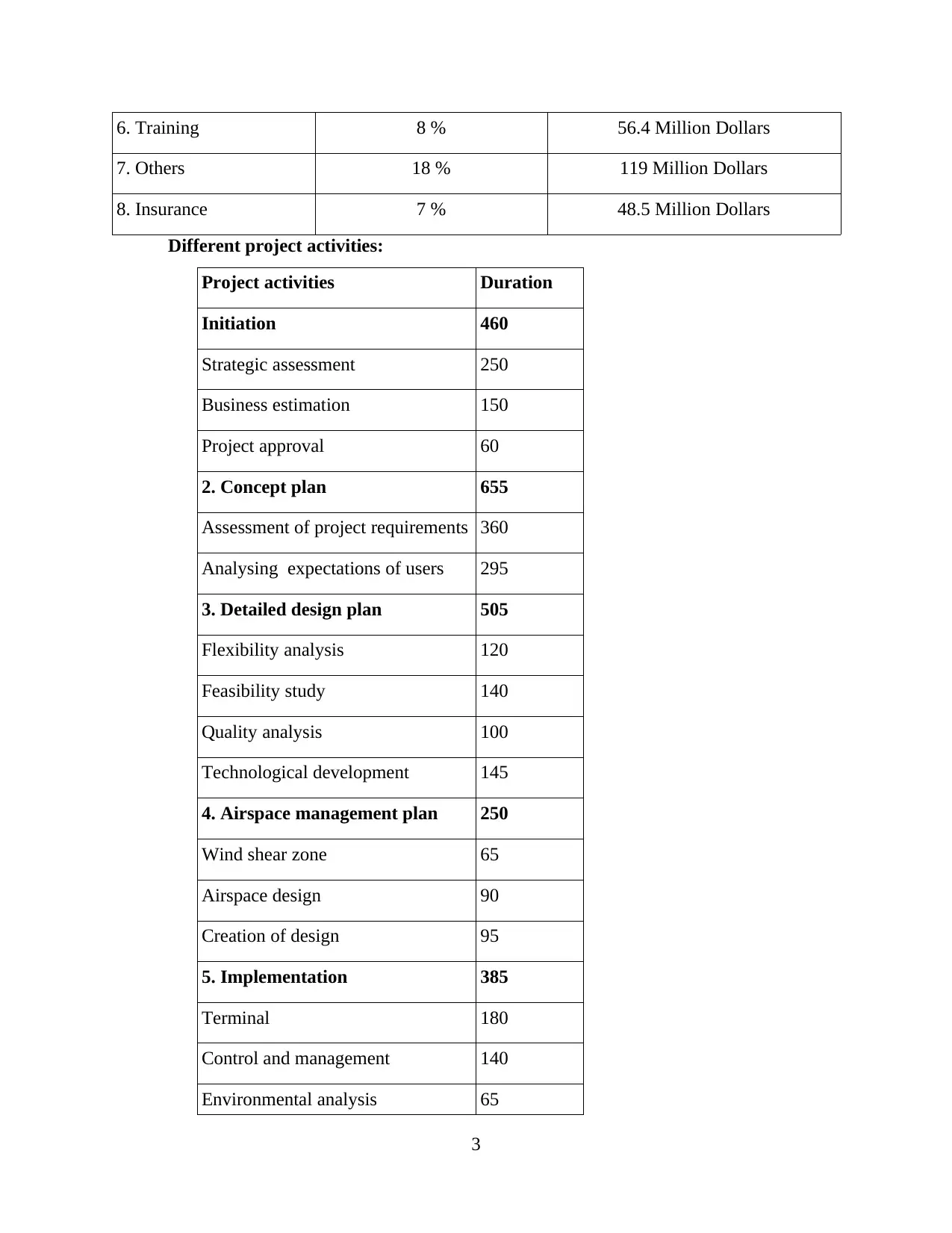
6. Training 8 % 56.4 Million Dollars
7. Others 18 % 119 Million Dollars
8. Insurance 7 % 48.5 Million Dollars
Different project activities:
Project activities Duration
Initiation 460
Strategic assessment 250
Business estimation 150
Project approval 60
2. Concept plan 655
Assessment of project requirements 360
Analysing expectations of users 295
3. Detailed design plan 505
Flexibility analysis 120
Feasibility study 140
Quality analysis 100
Technological development 145
4. Airspace management plan 250
Wind shear zone 65
Airspace design 90
Creation of design 95
5. Implementation 385
Terminal 180
Control and management 140
Environmental analysis 65
3
7. Others 18 % 119 Million Dollars
8. Insurance 7 % 48.5 Million Dollars
Different project activities:
Project activities Duration
Initiation 460
Strategic assessment 250
Business estimation 150
Project approval 60
2. Concept plan 655
Assessment of project requirements 360
Analysing expectations of users 295
3. Detailed design plan 505
Flexibility analysis 120
Feasibility study 140
Quality analysis 100
Technological development 145
4. Airspace management plan 250
Wind shear zone 65
Airspace design 90
Creation of design 95
5. Implementation 385
Terminal 180
Control and management 140
Environmental analysis 65
3
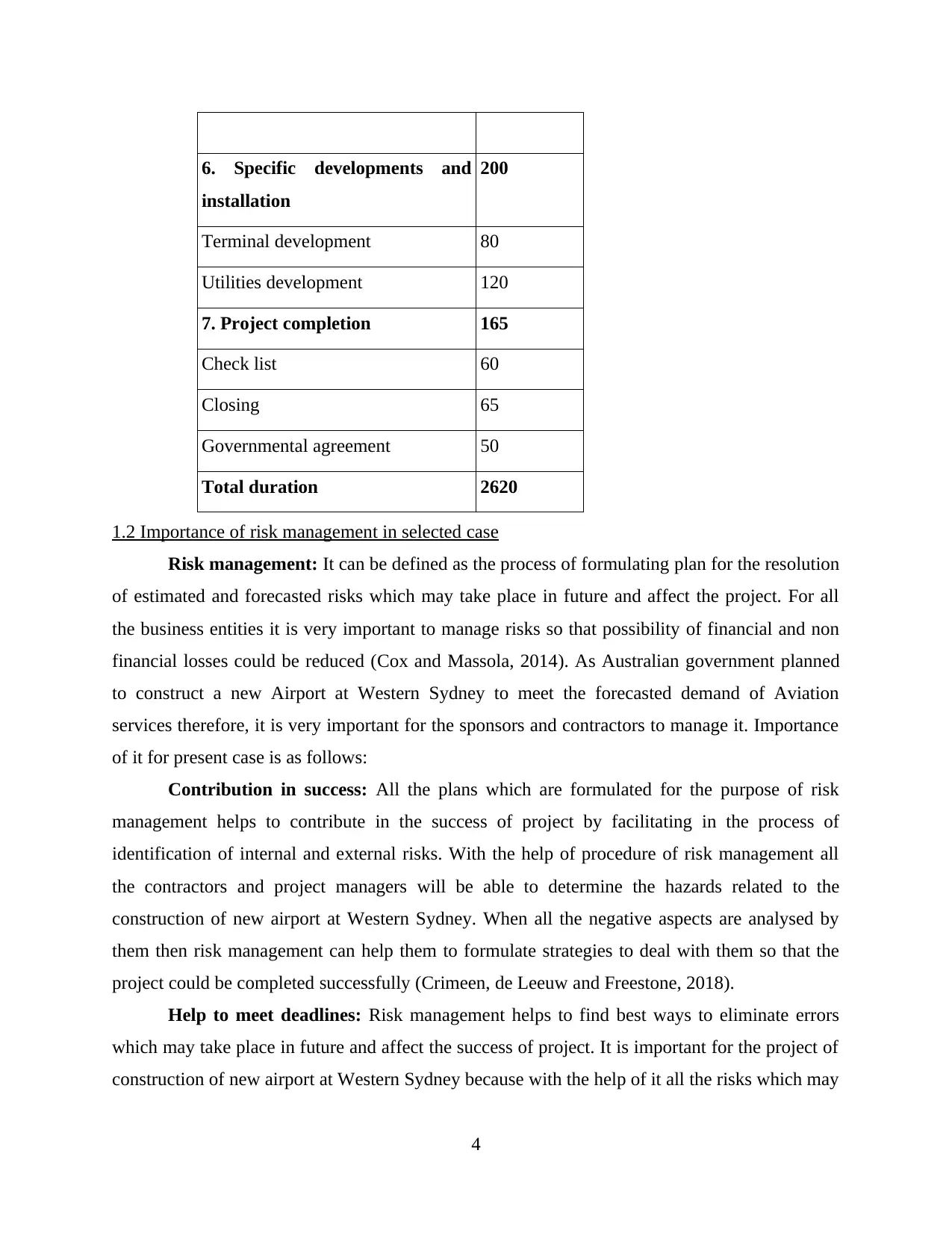
6. Specific developments and
installation
200
Terminal development 80
Utilities development 120
7. Project completion 165
Check list 60
Closing 65
Governmental agreement 50
Total duration 2620
1.2 Importance of risk management in selected case
Risk management: It can be defined as the process of formulating plan for the resolution
of estimated and forecasted risks which may take place in future and affect the project. For all
the business entities it is very important to manage risks so that possibility of financial and non
financial losses could be reduced (Cox and Massola, 2014). As Australian government planned
to construct a new Airport at Western Sydney to meet the forecasted demand of Aviation
services therefore, it is very important for the sponsors and contractors to manage it. Importance
of it for present case is as follows:
Contribution in success: All the plans which are formulated for the purpose of risk
management helps to contribute in the success of project by facilitating in the process of
identification of internal and external risks. With the help of procedure of risk management all
the contractors and project managers will be able to determine the hazards related to the
construction of new airport at Western Sydney. When all the negative aspects are analysed by
them then risk management can help them to formulate strategies to deal with them so that the
project could be completed successfully (Crimeen, de Leeuw and Freestone, 2018).
Help to meet deadlines: Risk management helps to find best ways to eliminate errors
which may take place in future and affect the success of project. It is important for the project of
construction of new airport at Western Sydney because with the help of it all the risks which may
4
installation
200
Terminal development 80
Utilities development 120
7. Project completion 165
Check list 60
Closing 65
Governmental agreement 50
Total duration 2620
1.2 Importance of risk management in selected case
Risk management: It can be defined as the process of formulating plan for the resolution
of estimated and forecasted risks which may take place in future and affect the project. For all
the business entities it is very important to manage risks so that possibility of financial and non
financial losses could be reduced (Cox and Massola, 2014). As Australian government planned
to construct a new Airport at Western Sydney to meet the forecasted demand of Aviation
services therefore, it is very important for the sponsors and contractors to manage it. Importance
of it for present case is as follows:
Contribution in success: All the plans which are formulated for the purpose of risk
management helps to contribute in the success of project by facilitating in the process of
identification of internal and external risks. With the help of procedure of risk management all
the contractors and project managers will be able to determine the hazards related to the
construction of new airport at Western Sydney. When all the negative aspects are analysed by
them then risk management can help them to formulate strategies to deal with them so that the
project could be completed successfully (Crimeen, de Leeuw and Freestone, 2018).
Help to meet deadlines: Risk management helps to find best ways to eliminate errors
which may take place in future and affect the success of project. It is important for the project of
construction of new airport at Western Sydney because with the help of it all the risks which may
4
⊘ This is a preview!⊘
Do you want full access?
Subscribe today to unlock all pages.

Trusted by 1+ million students worldwide
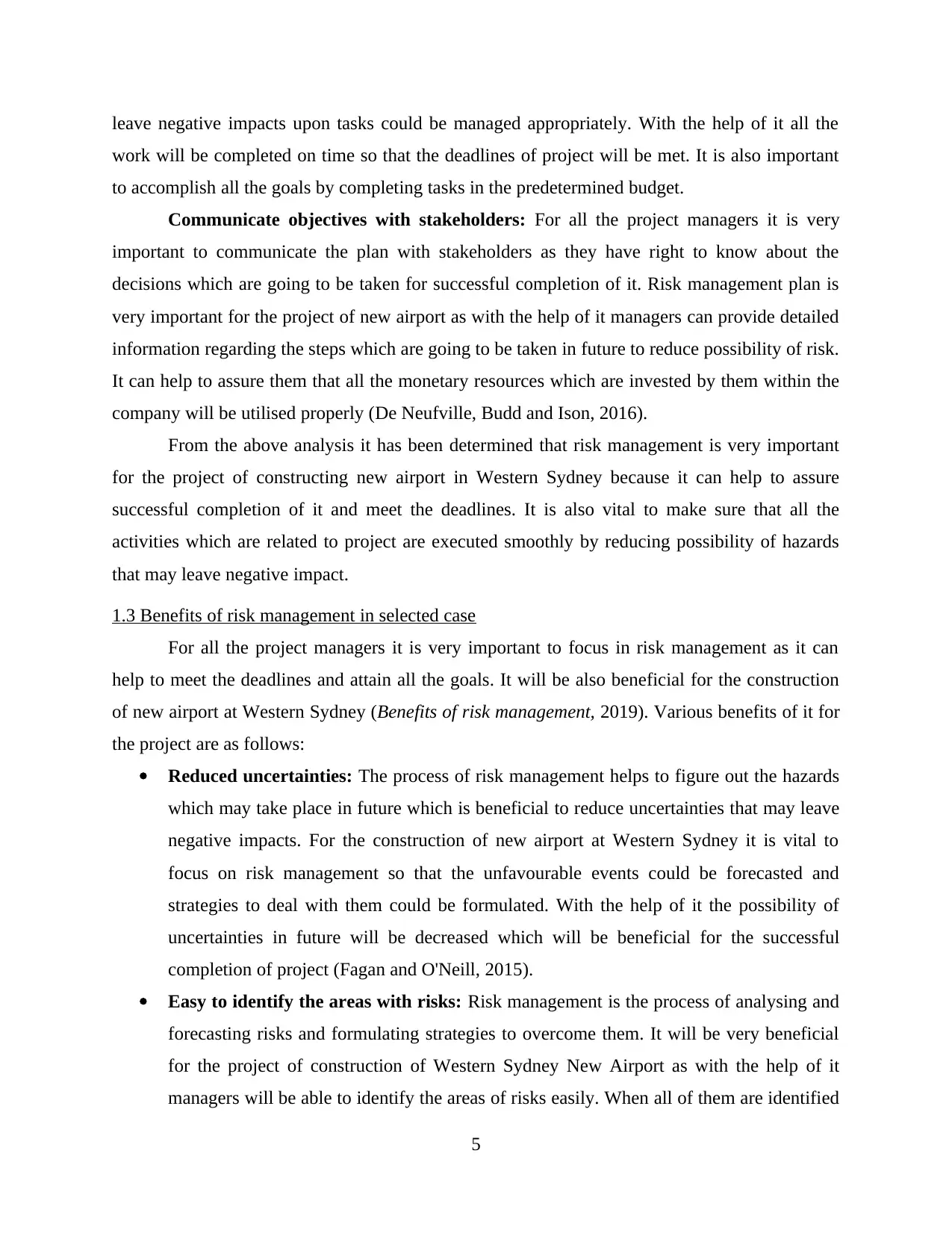
leave negative impacts upon tasks could be managed appropriately. With the help of it all the
work will be completed on time so that the deadlines of project will be met. It is also important
to accomplish all the goals by completing tasks in the predetermined budget.
Communicate objectives with stakeholders: For all the project managers it is very
important to communicate the plan with stakeholders as they have right to know about the
decisions which are going to be taken for successful completion of it. Risk management plan is
very important for the project of new airport as with the help of it managers can provide detailed
information regarding the steps which are going to be taken in future to reduce possibility of risk.
It can help to assure them that all the monetary resources which are invested by them within the
company will be utilised properly (De Neufville, Budd and Ison, 2016).
From the above analysis it has been determined that risk management is very important
for the project of constructing new airport in Western Sydney because it can help to assure
successful completion of it and meet the deadlines. It is also vital to make sure that all the
activities which are related to project are executed smoothly by reducing possibility of hazards
that may leave negative impact.
1.3 Benefits of risk management in selected case
For all the project managers it is very important to focus in risk management as it can
help to meet the deadlines and attain all the goals. It will be also beneficial for the construction
of new airport at Western Sydney (Benefits of risk management, 2019). Various benefits of it for
the project are as follows:
Reduced uncertainties: The process of risk management helps to figure out the hazards
which may take place in future which is beneficial to reduce uncertainties that may leave
negative impacts. For the construction of new airport at Western Sydney it is vital to
focus on risk management so that the unfavourable events could be forecasted and
strategies to deal with them could be formulated. With the help of it the possibility of
uncertainties in future will be decreased which will be beneficial for the successful
completion of project (Fagan and O'Neill, 2015).
Easy to identify the areas with risks: Risk management is the process of analysing and
forecasting risks and formulating strategies to overcome them. It will be very beneficial
for the project of construction of Western Sydney New Airport as with the help of it
managers will be able to identify the areas of risks easily. When all of them are identified
5
work will be completed on time so that the deadlines of project will be met. It is also important
to accomplish all the goals by completing tasks in the predetermined budget.
Communicate objectives with stakeholders: For all the project managers it is very
important to communicate the plan with stakeholders as they have right to know about the
decisions which are going to be taken for successful completion of it. Risk management plan is
very important for the project of new airport as with the help of it managers can provide detailed
information regarding the steps which are going to be taken in future to reduce possibility of risk.
It can help to assure them that all the monetary resources which are invested by them within the
company will be utilised properly (De Neufville, Budd and Ison, 2016).
From the above analysis it has been determined that risk management is very important
for the project of constructing new airport in Western Sydney because it can help to assure
successful completion of it and meet the deadlines. It is also vital to make sure that all the
activities which are related to project are executed smoothly by reducing possibility of hazards
that may leave negative impact.
1.3 Benefits of risk management in selected case
For all the project managers it is very important to focus in risk management as it can
help to meet the deadlines and attain all the goals. It will be also beneficial for the construction
of new airport at Western Sydney (Benefits of risk management, 2019). Various benefits of it for
the project are as follows:
Reduced uncertainties: The process of risk management helps to figure out the hazards
which may take place in future which is beneficial to reduce uncertainties that may leave
negative impacts. For the construction of new airport at Western Sydney it is vital to
focus on risk management so that the unfavourable events could be forecasted and
strategies to deal with them could be formulated. With the help of it the possibility of
uncertainties in future will be decreased which will be beneficial for the successful
completion of project (Fagan and O'Neill, 2015).
Easy to identify the areas with risks: Risk management is the process of analysing and
forecasting risks and formulating strategies to overcome them. It will be very beneficial
for the project of construction of Western Sydney New Airport as with the help of it
managers will be able to identify the areas of risks easily. When all of them are identified
5
Paraphrase This Document
Need a fresh take? Get an instant paraphrase of this document with our AI Paraphraser
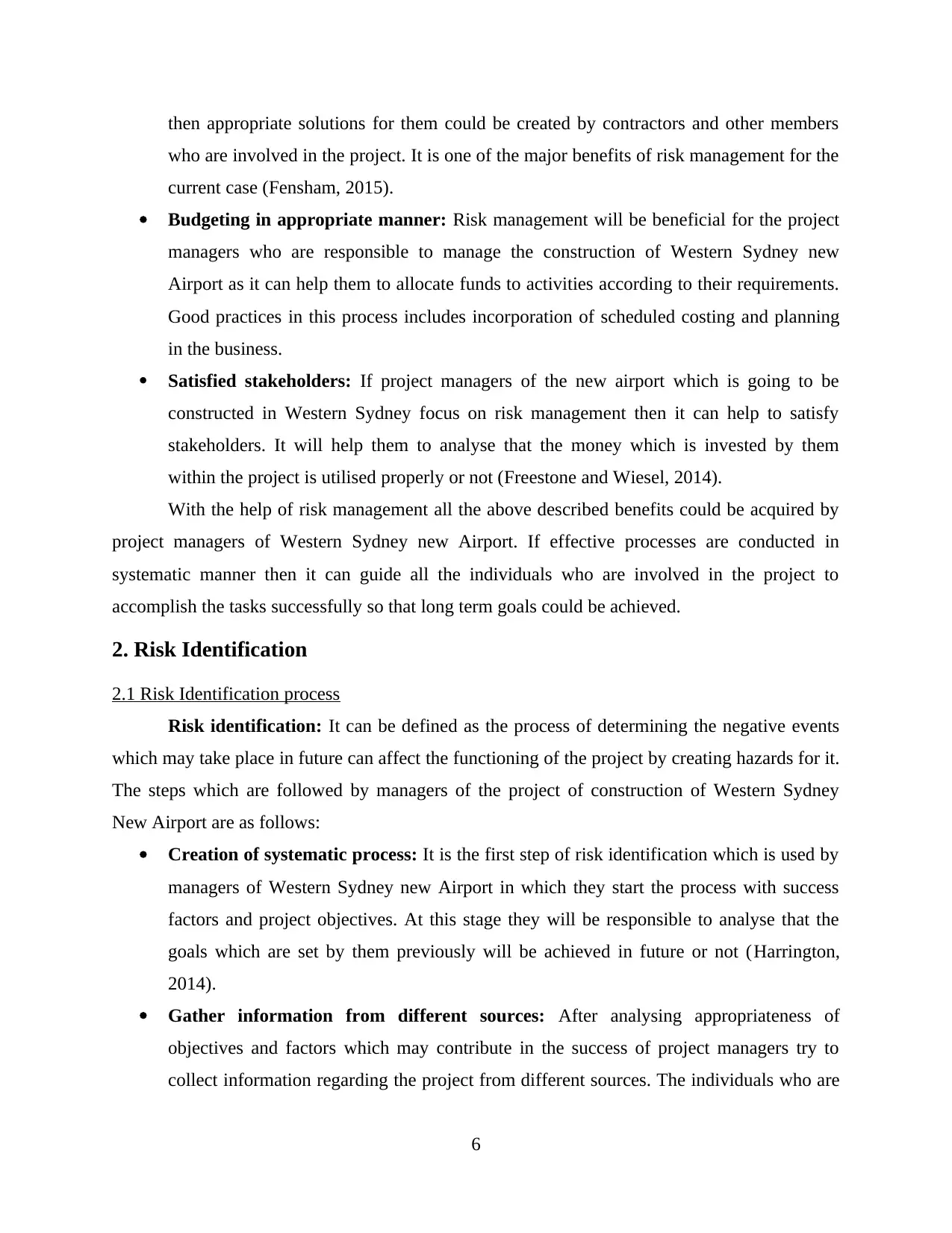
then appropriate solutions for them could be created by contractors and other members
who are involved in the project. It is one of the major benefits of risk management for the
current case (Fensham, 2015).
Budgeting in appropriate manner: Risk management will be beneficial for the project
managers who are responsible to manage the construction of Western Sydney new
Airport as it can help them to allocate funds to activities according to their requirements.
Good practices in this process includes incorporation of scheduled costing and planning
in the business.
Satisfied stakeholders: If project managers of the new airport which is going to be
constructed in Western Sydney focus on risk management then it can help to satisfy
stakeholders. It will help them to analyse that the money which is invested by them
within the project is utilised properly or not (Freestone and Wiesel, 2014).
With the help of risk management all the above described benefits could be acquired by
project managers of Western Sydney new Airport. If effective processes are conducted in
systematic manner then it can guide all the individuals who are involved in the project to
accomplish the tasks successfully so that long term goals could be achieved.
2. Risk Identification
2.1 Risk Identification process
Risk identification: It can be defined as the process of determining the negative events
which may take place in future can affect the functioning of the project by creating hazards for it.
The steps which are followed by managers of the project of construction of Western Sydney
New Airport are as follows:
Creation of systematic process: It is the first step of risk identification which is used by
managers of Western Sydney new Airport in which they start the process with success
factors and project objectives. At this stage they will be responsible to analyse that the
goals which are set by them previously will be achieved in future or not (Harrington,
2014).
Gather information from different sources: After analysing appropriateness of
objectives and factors which may contribute in the success of project managers try to
collect information regarding the project from different sources. The individuals who are
6
who are involved in the project. It is one of the major benefits of risk management for the
current case (Fensham, 2015).
Budgeting in appropriate manner: Risk management will be beneficial for the project
managers who are responsible to manage the construction of Western Sydney new
Airport as it can help them to allocate funds to activities according to their requirements.
Good practices in this process includes incorporation of scheduled costing and planning
in the business.
Satisfied stakeholders: If project managers of the new airport which is going to be
constructed in Western Sydney focus on risk management then it can help to satisfy
stakeholders. It will help them to analyse that the money which is invested by them
within the project is utilised properly or not (Freestone and Wiesel, 2014).
With the help of risk management all the above described benefits could be acquired by
project managers of Western Sydney new Airport. If effective processes are conducted in
systematic manner then it can guide all the individuals who are involved in the project to
accomplish the tasks successfully so that long term goals could be achieved.
2. Risk Identification
2.1 Risk Identification process
Risk identification: It can be defined as the process of determining the negative events
which may take place in future can affect the functioning of the project by creating hazards for it.
The steps which are followed by managers of the project of construction of Western Sydney
New Airport are as follows:
Creation of systematic process: It is the first step of risk identification which is used by
managers of Western Sydney new Airport in which they start the process with success
factors and project objectives. At this stage they will be responsible to analyse that the
goals which are set by them previously will be achieved in future or not (Harrington,
2014).
Gather information from different sources: After analysing appropriateness of
objectives and factors which may contribute in the success of project managers try to
collect information regarding the project from different sources. The individuals who are
6
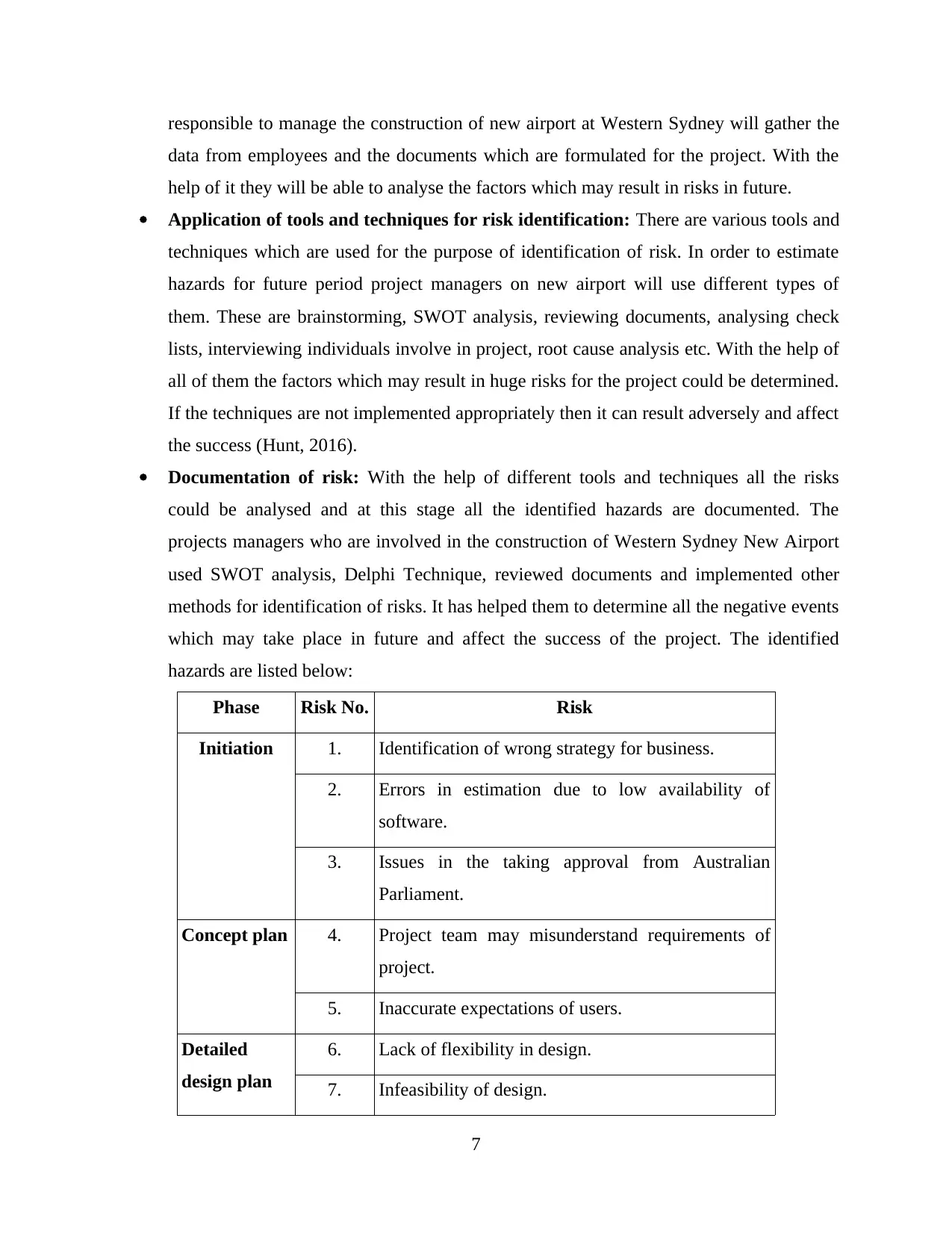
responsible to manage the construction of new airport at Western Sydney will gather the
data from employees and the documents which are formulated for the project. With the
help of it they will be able to analyse the factors which may result in risks in future.
Application of tools and techniques for risk identification: There are various tools and
techniques which are used for the purpose of identification of risk. In order to estimate
hazards for future period project managers on new airport will use different types of
them. These are brainstorming, SWOT analysis, reviewing documents, analysing check
lists, interviewing individuals involve in project, root cause analysis etc. With the help of
all of them the factors which may result in huge risks for the project could be determined.
If the techniques are not implemented appropriately then it can result adversely and affect
the success (Hunt, 2016).
Documentation of risk: With the help of different tools and techniques all the risks
could be analysed and at this stage all the identified hazards are documented. The
projects managers who are involved in the construction of Western Sydney New Airport
used SWOT analysis, Delphi Technique, reviewed documents and implemented other
methods for identification of risks. It has helped them to determine all the negative events
which may take place in future and affect the success of the project. The identified
hazards are listed below:
Phase Risk No. Risk
Initiation 1. Identification of wrong strategy for business.
2. Errors in estimation due to low availability of
software.
3. Issues in the taking approval from Australian
Parliament.
Concept plan 4. Project team may misunderstand requirements of
project.
5. Inaccurate expectations of users.
Detailed
design plan
6. Lack of flexibility in design.
7. Infeasibility of design.
7
data from employees and the documents which are formulated for the project. With the
help of it they will be able to analyse the factors which may result in risks in future.
Application of tools and techniques for risk identification: There are various tools and
techniques which are used for the purpose of identification of risk. In order to estimate
hazards for future period project managers on new airport will use different types of
them. These are brainstorming, SWOT analysis, reviewing documents, analysing check
lists, interviewing individuals involve in project, root cause analysis etc. With the help of
all of them the factors which may result in huge risks for the project could be determined.
If the techniques are not implemented appropriately then it can result adversely and affect
the success (Hunt, 2016).
Documentation of risk: With the help of different tools and techniques all the risks
could be analysed and at this stage all the identified hazards are documented. The
projects managers who are involved in the construction of Western Sydney New Airport
used SWOT analysis, Delphi Technique, reviewed documents and implemented other
methods for identification of risks. It has helped them to determine all the negative events
which may take place in future and affect the success of the project. The identified
hazards are listed below:
Phase Risk No. Risk
Initiation 1. Identification of wrong strategy for business.
2. Errors in estimation due to low availability of
software.
3. Issues in the taking approval from Australian
Parliament.
Concept plan 4. Project team may misunderstand requirements of
project.
5. Inaccurate expectations of users.
Detailed
design plan
6. Lack of flexibility in design.
7. Infeasibility of design.
7
⊘ This is a preview!⊘
Do you want full access?
Subscribe today to unlock all pages.

Trusted by 1+ million students worldwide
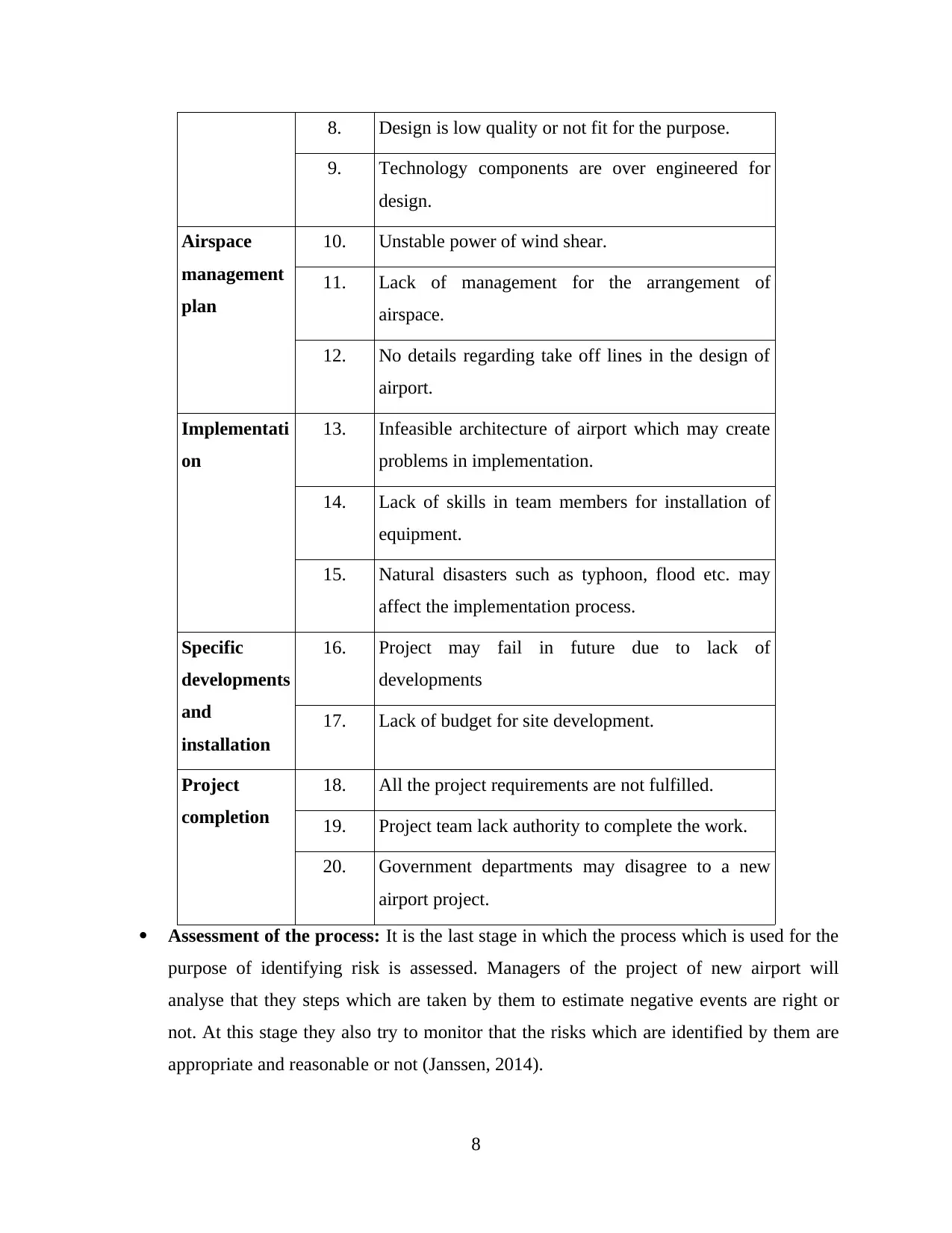
8. Design is low quality or not fit for the purpose.
9. Technology components are over engineered for
design.
Airspace
management
plan
10. Unstable power of wind shear.
11. Lack of management for the arrangement of
airspace.
12. No details regarding take off lines in the design of
airport.
Implementati
on
13. Infeasible architecture of airport which may create
problems in implementation.
14. Lack of skills in team members for installation of
equipment.
15. Natural disasters such as typhoon, flood etc. may
affect the implementation process.
Specific
developments
and
installation
16. Project may fail in future due to lack of
developments
17. Lack of budget for site development.
Project
completion
18. All the project requirements are not fulfilled.
19. Project team lack authority to complete the work.
20. Government departments may disagree to a new
airport project.
Assessment of the process: It is the last stage in which the process which is used for the
purpose of identifying risk is assessed. Managers of the project of new airport will
analyse that they steps which are taken by them to estimate negative events are right or
not. At this stage they also try to monitor that the risks which are identified by them are
appropriate and reasonable or not (Janssen, 2014).
8
9. Technology components are over engineered for
design.
Airspace
management
plan
10. Unstable power of wind shear.
11. Lack of management for the arrangement of
airspace.
12. No details regarding take off lines in the design of
airport.
Implementati
on
13. Infeasible architecture of airport which may create
problems in implementation.
14. Lack of skills in team members for installation of
equipment.
15. Natural disasters such as typhoon, flood etc. may
affect the implementation process.
Specific
developments
and
installation
16. Project may fail in future due to lack of
developments
17. Lack of budget for site development.
Project
completion
18. All the project requirements are not fulfilled.
19. Project team lack authority to complete the work.
20. Government departments may disagree to a new
airport project.
Assessment of the process: It is the last stage in which the process which is used for the
purpose of identifying risk is assessed. Managers of the project of new airport will
analyse that they steps which are taken by them to estimate negative events are right or
not. At this stage they also try to monitor that the risks which are identified by them are
appropriate and reasonable or not (Janssen, 2014).
8
Paraphrase This Document
Need a fresh take? Get an instant paraphrase of this document with our AI Paraphraser
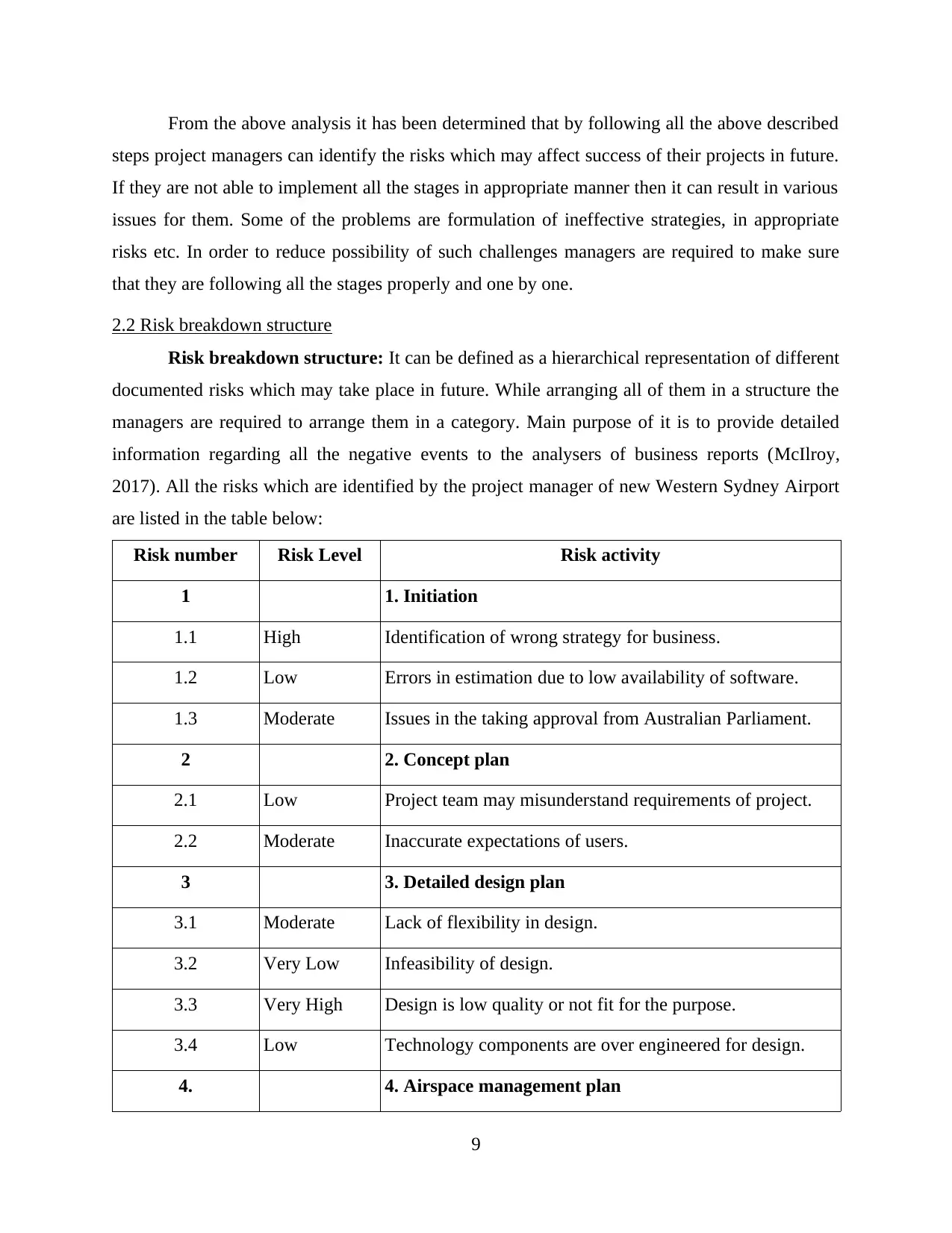
From the above analysis it has been determined that by following all the above described
steps project managers can identify the risks which may affect success of their projects in future.
If they are not able to implement all the stages in appropriate manner then it can result in various
issues for them. Some of the problems are formulation of ineffective strategies, in appropriate
risks etc. In order to reduce possibility of such challenges managers are required to make sure
that they are following all the stages properly and one by one.
2.2 Risk breakdown structure
Risk breakdown structure: It can be defined as a hierarchical representation of different
documented risks which may take place in future. While arranging all of them in a structure the
managers are required to arrange them in a category. Main purpose of it is to provide detailed
information regarding all the negative events to the analysers of business reports (McIlroy,
2017). All the risks which are identified by the project manager of new Western Sydney Airport
are listed in the table below:
Risk number Risk Level Risk activity
1 1. Initiation
1.1 High Identification of wrong strategy for business.
1.2 Low Errors in estimation due to low availability of software.
1.3 Moderate Issues in the taking approval from Australian Parliament.
2 2. Concept plan
2.1 Low Project team may misunderstand requirements of project.
2.2 Moderate Inaccurate expectations of users.
3 3. Detailed design plan
3.1 Moderate Lack of flexibility in design.
3.2 Very Low Infeasibility of design.
3.3 Very High Design is low quality or not fit for the purpose.
3.4 Low Technology components are over engineered for design.
4. 4. Airspace management plan
9
steps project managers can identify the risks which may affect success of their projects in future.
If they are not able to implement all the stages in appropriate manner then it can result in various
issues for them. Some of the problems are formulation of ineffective strategies, in appropriate
risks etc. In order to reduce possibility of such challenges managers are required to make sure
that they are following all the stages properly and one by one.
2.2 Risk breakdown structure
Risk breakdown structure: It can be defined as a hierarchical representation of different
documented risks which may take place in future. While arranging all of them in a structure the
managers are required to arrange them in a category. Main purpose of it is to provide detailed
information regarding all the negative events to the analysers of business reports (McIlroy,
2017). All the risks which are identified by the project manager of new Western Sydney Airport
are listed in the table below:
Risk number Risk Level Risk activity
1 1. Initiation
1.1 High Identification of wrong strategy for business.
1.2 Low Errors in estimation due to low availability of software.
1.3 Moderate Issues in the taking approval from Australian Parliament.
2 2. Concept plan
2.1 Low Project team may misunderstand requirements of project.
2.2 Moderate Inaccurate expectations of users.
3 3. Detailed design plan
3.1 Moderate Lack of flexibility in design.
3.2 Very Low Infeasibility of design.
3.3 Very High Design is low quality or not fit for the purpose.
3.4 Low Technology components are over engineered for design.
4. 4. Airspace management plan
9
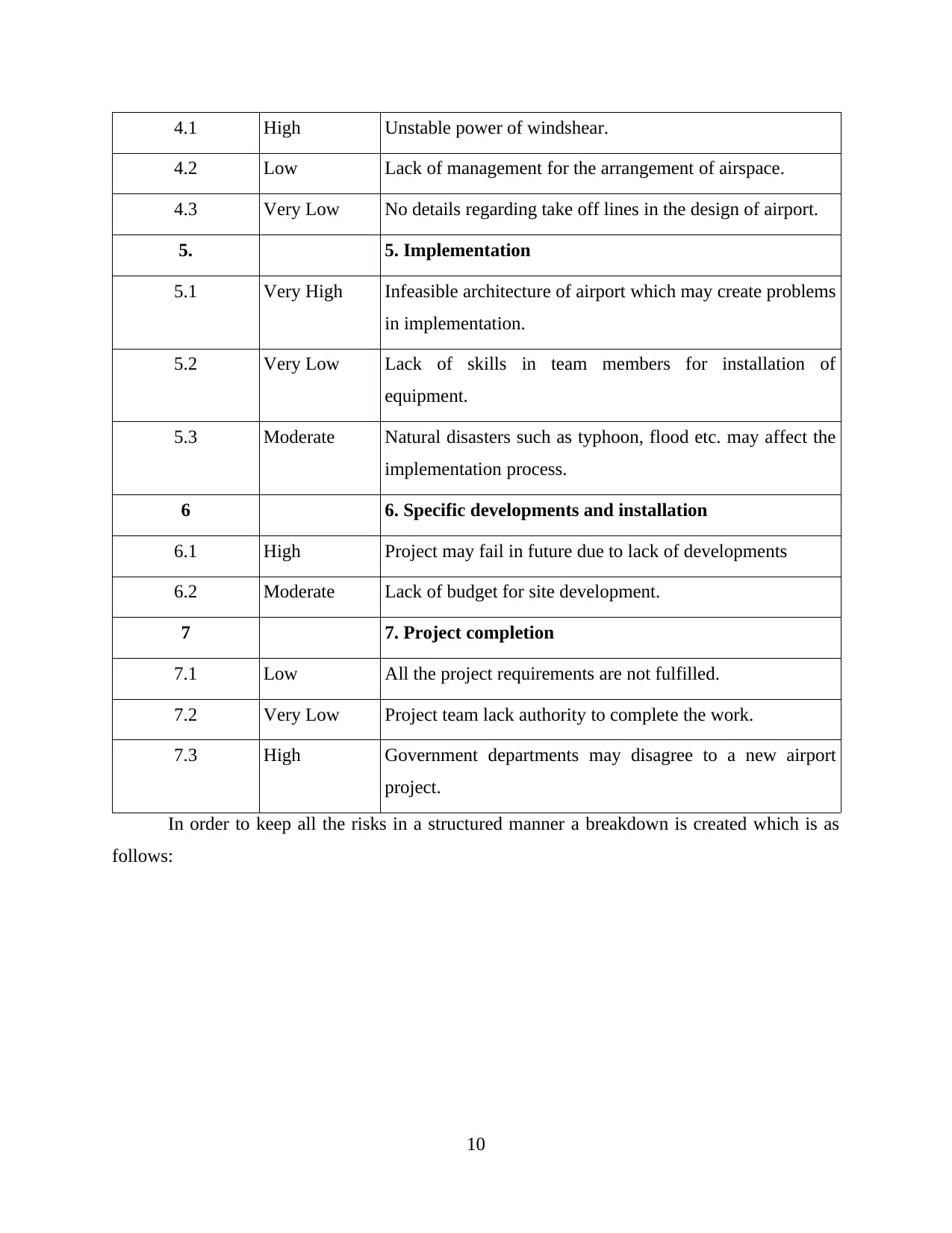
4.1 High Unstable power of windshear.
4.2 Low Lack of management for the arrangement of airspace.
4.3 Very Low No details regarding take off lines in the design of airport.
5. 5. Implementation
5.1 Very High Infeasible architecture of airport which may create problems
in implementation.
5.2 Very Low Lack of skills in team members for installation of
equipment.
5.3 Moderate Natural disasters such as typhoon, flood etc. may affect the
implementation process.
6 6. Specific developments and installation
6.1 High Project may fail in future due to lack of developments
6.2 Moderate Lack of budget for site development.
7 7. Project completion
7.1 Low All the project requirements are not fulfilled.
7.2 Very Low Project team lack authority to complete the work.
7.3 High Government departments may disagree to a new airport
project.
In order to keep all the risks in a structured manner a breakdown is created which is as
follows:
10
4.2 Low Lack of management for the arrangement of airspace.
4.3 Very Low No details regarding take off lines in the design of airport.
5. 5. Implementation
5.1 Very High Infeasible architecture of airport which may create problems
in implementation.
5.2 Very Low Lack of skills in team members for installation of
equipment.
5.3 Moderate Natural disasters such as typhoon, flood etc. may affect the
implementation process.
6 6. Specific developments and installation
6.1 High Project may fail in future due to lack of developments
6.2 Moderate Lack of budget for site development.
7 7. Project completion
7.1 Low All the project requirements are not fulfilled.
7.2 Very Low Project team lack authority to complete the work.
7.3 High Government departments may disagree to a new airport
project.
In order to keep all the risks in a structured manner a breakdown is created which is as
follows:
10
⊘ This is a preview!⊘
Do you want full access?
Subscribe today to unlock all pages.

Trusted by 1+ million students worldwide
1 out of 22
Related Documents
Your All-in-One AI-Powered Toolkit for Academic Success.
+13062052269
info@desklib.com
Available 24*7 on WhatsApp / Email
![[object Object]](/_next/static/media/star-bottom.7253800d.svg)
Unlock your academic potential
Copyright © 2020–2025 A2Z Services. All Rights Reserved. Developed and managed by ZUCOL.



